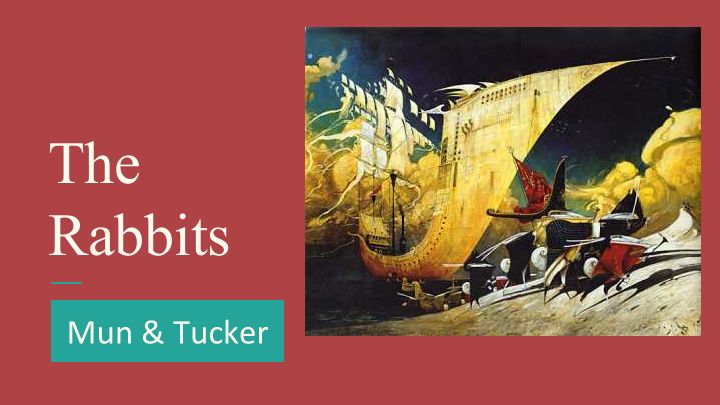



The Rabbits Mun & Tucker
Agenda Reading The Rabbits Info about the text Plot Themes Merits Challenges Important Considerations When Teaching this Text
The Rabbits by John Marsden and Shaun Tan Plotline: The Rabbits , a picture book written by John Marsden and illustrated by Shaun Tan, is partly allegorical fable about colonisation, told from the viewpoint of the “colonised”. An unseen narrator describes the coming of ‘rabbits’ in the most minimal detail, an encounter that is at first friendly and curious, but later darkens as it becomes apparent that the visitors are actually invaders.
The Rabbits by John Marsden and Shaun Tan Genre: Picture Book Target Age Group: 12-17 (mature themes and concepts) Dominant Themes: The generational effects of colonization on Aboriginal communities Environmental education and humanity’s relationship to land Power vs. powerlessness The perils of technology and industry
Merits of the Book: Simple and accessible vocabulary (great for ELL students). Short and succinct . Detailed and expressive artwork is very appealing to the eye. Focuses on complex and mature themes . Makes students reconsider who picture books can be made for , and what they can be about . Awarded Picture Book of the Year by the Children’s Book Council.
Challenges of the Book: Complicated, mature, and delicate themes necessitate substantial contextualization and scaffolding . Potentially problematic ending in depicting the colonized as helpless or needing to be saved, needs to be discussed and challenged . In-depth visual analysis may require frontloading of visual literacy vocabulary and analysis skills. This texts begets questions of authorial authenticity based on the subject matter (Shaun Tan is of Malaysian-Chinese and Anglo-Irish heritage).
Important Considerations When Teaching this Text Make sure to inform students that simply equating one example of colonization, or one aboriginal experience , with any other, is reductive and tokenistic . Explain the implications of teaching a text with an allegory for aboriginal colonization authored from non-aboriginal individuals. What are the implications of letting non- aboriginal individuals tell the story of aboriginals?
Shaun Tan’s Interpretation “The Rabbits is a story of universes colliding; one culture driven by powerful technology that transcends nature (much like our own), and another whose spirit is embedded in an ancient ecology. “The Rabbits is about a deep environmental crisis, a crisis of conscience, and a costly failure of communication. At the end the question of reconciliation is left open to the reader as it is in the real world: The future, as always, remains undecided” (Tan 1998).
Teaching Possibilities Explore truth and reconciliation resources and the effects of colonization on generations of Aboriginals. Pair with Nicola Campbell’s Shi-Shi-Etko and Shin- Chi’s Canoe to further explore the topic of residential schools , or with Thomas King’s The Inconvenient Indian in senior grades to explore colonization as a whole. Students can engage in a close reading of the visuals of the book, and analyze images and symbols in relationship to the text. Students could conduct a study of other “mature” picture books (e.g. The Island by Armin Greder, The Red Tree by Shaun Tan) and compare them to the form and content of traditional picture books aimed at younger audiences. Discuss the ending of the text and why it could be considered to be problematic in its depiction of aboriginal peoples as helpless.
Teaching Possibilities (Continued) Students can compare The Rabbits to the historical paintings and imagery that inspired Shaun Tan’s visuals (e.g. “The Landing of Captain Cook at Botany Bay” by E. Phillips Fox). Students can take on the roles of either Rabbits or Marsupials and act out a series of tableaus that retell or interpret the events of the text from different points of view. Students can work to create soundscapes of the Marsupial’s home, before and after the Rabbits arrive. The class can watch and analyze the opera adaptation of the text, considering the many additions and changes made in translation.
Close Reading Activity In your groups review one spread from The Rabbits to analyze and discuss the visuals in relation to the allegory of Aboriginal colonization from the Europeans. List some of your observations on the chart paper. You will have 2-3 minutes at each station.
Exemplar:
What to Look for in your Visual Analysis: Line Balance Shape Contrast Colour Emphasis Value Movement Form Pattern Texture Rhythm Space Unity
Questions?
Resources Bradford, C. (2011). Reading Indigeneity: The ethics of interpretation and representation, in Handbook of research on children’s and young adult literature, Routledge, New York, 331-342. Greder, A. (2007). The island . Crows Nest, N.S.W: Allen & Unwin. King, T. (2012). The inconvenient indian: A curious account of native people in north america . Toronto: Doubleday Canada. Marsden, J., & Tan, S. (2003). The rabbits . Vancouver: Simply Read Books. Righting Canada’s Wrongs: Residential Schools – the devastating impact on Canada’s Indigenous Peoples and the Truth and Reconciliation Commission’s Findings and Calls for Action. Florence, Melanie, 2016 . James Lorimer & Company Ltd, Publishers. Shaun Tan. (n.d.). Retrieved July 30, 2016, from http://www.shauntan.net/ Shaun Tan & Jomden Pty LTD. The Rabbits. Arvine A. Levine Books: an imprint of Scholastic Inc. Shi-shi-etko. Nicola I. Campbell, 2005. Groundwood Books: House of Anansi Press. Shin-chi’s Canoe. Nicola I. Campbell, 2008. Groundwood Books: House of Anansi Press. Tan, S. (2002). The red tree . Vancouver: Simply Read Books.
Recommend
More recommend